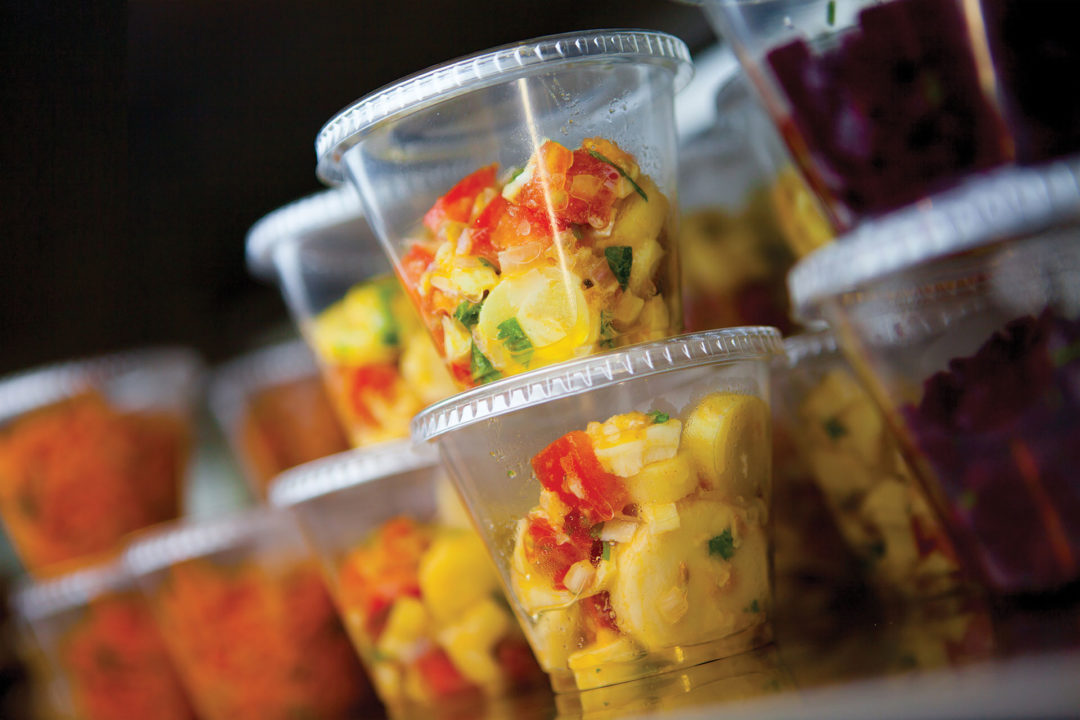Some of the biggest changes in foot traffic, reported in the 2015 WholeFoods Retailer Survey, were experienced by stores in which 20–54% of their total annual sales came from perishables. While the 20–34% perishables group went from 245 customers/day in 2014 to 305 daily shoppers in 2015, the 35–54% perishables group grew from 480 shoppers/day in 2014 to 555 daily transactions in 2015 (1).
What’s important to note is that retailers in the 10–19% perishables group lost 5% of their daily shoppers, going from 97 shoppers per day in 2014 to 92 in 2015. Although 51% of the retailers’ sales came from dietary supplements, the group pulled in lower foot traffic than small supplement chains and smaller perishables-focused stores due to a focus on monthly stock up items and little to no focus on fresh produce or prepared foods, which have become a strong magnet for daily or weekly shoppers.
What can retailers do to stay ahead of this trend? Start off by understanding the new needs of today’s consumers.
Millennials and Sales GrowthOne generation that seems to be creating a meaningful impact on this latest food trend are Millennials. Jay Jacobowitz, president and founder of Retail Insights, Brattleboro, VT, and WholeFoods merchandising editor, says Millennials and Gen-Y are demanding less processed fresh and prepared foods.
“The consumer has been in, now, a decades-long period of redefining quality in food,” states Jacobowitz. “No longer are most shelf-stable foods—that is non-refrigerated packaged foods and highly processed foods—considered high quality by consumers. Fresh is a proxy for high quality. The assumption is that it is a simpler, healthier way to eat.”
And don’t count on Gen-X or Baby Boomers to believe otherwise. “While they are not as persistent, they do agree with the redefinition of food quality towards fresh,” states Jacobowitz.
Store IdentityOne of the most important aspects of being a successful natural products retailer is a clear identity. David Chavez, vice president of Central Region sales and national director of food service sales at United Natural Foods, Inc. (UNFI), Providence, RI, says one staple a retailer must have before starting out in foods service and crafting a menu is to know the store’s message.
“Are we a natural food store that leans more toward providing vegetarians and vegans with food options, states Chavez. “Or a diverse mix of natural products with a variety of attributes? Are we a retailer that has more folks coming in the door that are not necessarily tied to an attribute or a lifestyle, such as vegetarian or vegan, but more so of thinking about natural foods in general?”
Stores need to nail this down to be successful—and to determine where prepared foods fall into all this.
What’s on the Menu?While the demand for “fresh, healthier and local” foods is driving consumers into stores for prepared meals, U.S. food culture has shifted away from the tradition of families eating “three square meals” together per day. Instead, it has fragmented into a flexible blend of multiple meals, snacks or a combination of the two throughout the day (3).
“It is probably not feasible to serve all three meal periods, breakfast, lunch and dinner,” says Jacobowitz. “We are now a snacking society and the idea of a meal has blurred with the idea of a snack. A snack now has even more nutrition than maybe a small meal. It can also substitute a meal and may eliminate a sit-down meal.”
Nearly half the time, Americans eat meals alone with consumers using the time to catch up on reading, email, work and other tasks. “The whole culture of meal times and shared meal experiences is also changing,” Jacobowitz states. “So, as a store deciding which meal periods to serve, it is probably useful to think about smaller plates that are nutritious but not necessarily elaborate.”
While Scott Sleckman, head executive chef at Dean’s Natural Food Market, Ocean, NJ, believes it’s best to pay attention to and have the top sellers in a store as a staple on the menu, Shannon Hoffman, co-owner and president of GreenAcres Markets, Wichita, KS, believes if a store is located around high-traffic areas, such as near offices and schools, then a retailer’s menu should focus mainly on quick and easy grab-and-go meals such as soups, snack packs, sandwiches and salads.
As for variety, Hoffman believes, “A deli is about consistency. It’s very different from a restaurant. People enter a deli thinking, ‘I’m in the mood for that chicken salad from GreenAcres,’ not necessarily, ‘I want to see what they are offering today.’”
Hoffman also believes in offering some variety. “We have probably 70% of our offerings as staples items and then rotate 30%, which includes a daily variety of soups, grab-and-go juices that we make.
When it comes to drinks, Chris Reed, founder, chairman and CEO of Reed’s, Inc., Los Angeles, CA, believes it’s important to keep a standard menu. “People are creatures of habit, so you can have a part of your drink menu that varies from seasonal drinks coming in. But, I wouldn’t vary daily choices too much because there is a reason why a number one drink is popular.”“Fresh is a proxy for high quality.” —Jay Jacobowitz, Retail Insights, WholeFoods Magazine
Chavez adds, “There’s a lot of fun to be had with menus, but it’s important to have your staples because you have to create a consistent experience that consumers count on.”
Food Service DisplayA great-looking creative presentation of prepared foods can be useful to help attract frequent shoppers. Hammed Atassi, vice president of food service and strategic development at Numi Organic Tea, Oakland, CA, notes that an artful display of ingredients used in a particular product may not only attract consumers to the section, but also encourage them to try something new.
“People love to see the beautiful, real ingredients that make up teas,” states Atassi. “Showing the quality organic ingredients helps diners appreciate the premium and pure nature of the product.” He suggests using special racks, chests and other point-of-sale materials such as posters, menus and tents to draw shoppers in.
Like Atassi, Chavez believes consumers would love to see ingredients from their favorite foods on display, but believes retailers should tie it into a story. “If a simple ingredient like parsley comes from a farm and there’s a story on how that parsley got to that store, tell it,” says Chavez. “Tell the story in an intimate way and make sure all the staff is trained on it. If you do this with an ingredient every week, two things are accomplished: Your customers are always getting a story to go with the prepared foods item they just bought and your staff is being trained on the sourcing that’s behind every single ingredient, which is ultimately hitting the consumer.”
For retailers that like a simple look, Reed says owners of natural shops that offer drinks from a fountain should then allow the equipment to do all of the talking. “The equipment for soda fountains and Kombucha drafts is very compelling,” Reed states. “The logos and beautiful chrome make it look modern and hip and will certainly attract people to it just to say, ‘Wow.’”
Another popular choice are demo stations, which Reed thinks will get consumers to try and buy. “If 19 out of 20 discover something wonderful, then demoing will always be a good idea.”
Not only can sampling bring shoppers back to the “perimeter of the store,” says Chavez, but it can also bring about “a broader experience for the customer, all while increasing basket size.”
Chavez also suggests natural retailers try to work with a layout that gives a flow from start to finish as a way to avoid theft in stores: “Imagine yourself walking through a sandwich shop, and the sandwich shop has a line where the sandwich is being made in front of you. Along that path, there’s also a drink case and the chips or snack items. As you reach the end of line, you then arrive at a register.”
Food SafetyOf course, retailers must also take several precautions with food safety. To avoid contamination, Sleckman suggests keeping items stored in proper temperatures and to make sure everyone on staff contributes to good personal hygiene practices such as keeping hands clean and hair covered.
For retailers brewing hot or cold tea, Atassi instructs staff members to “rotate standing ice tea every few hours to ensure freshness, to brew and serve iced tea from the urn of the dispensers and to follow the directions carefully and according to tea variety.”
For larger retail spaces, Reed suggests hiring an outside consultant. “It’s really worth its weight, especially with issues like contamination,” he feels.
Even shops specializing in gluten-free food service can acquire a certification from a third-party organization that will do training with staff to ensure that the facility abides by rules that ensure a gluten-free eating experience for customers. The Gluten-Free Certification Organization is one group that offers such a program.
LaborThe last set of danger, natural retailers should note are labor costs. “You want to concentrate your labor in the preparation of the food and minimize it in the serving of the food,” Jacobowitz states. “What kills profitability in stores—unless you have a very, very high foot traffic—is the dedicated employee behind the counter serving some portion of some meal component to order.”WF
Published in WholeFoods Magazine July 2016
References1. K. Chiarello-Ebner, “2015 WholeFoods Magazine Retailer Survey Overview,” WholeFoods Magazine, 38 (12), 18–25 (2015). 2. J. Jacobowitz, “A Rising Tide,” WholeFoods Magazine, 38 (12), 13 (2015). 3. J. Jacobowitz, “What’s For Dinner…Or Any Other Meal?” 39 (1), 41, 48 (2016).









